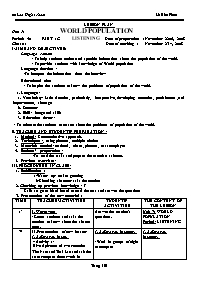Thiết kế bài dạy môn Tiếng Anh 11 - Unit 7: World population - Period: 40 - Part : C listening

I/AIMS AND OBJECTIVES:
+ Language content:
- To help students understand specific information about the population of the world.
- To provide students with knowledge of World population
+ Language function:
-To interpret the information from the interview
+ Educational aim:
- To inspire the students to know the problems of population of the world.
1.Language:
a. Vocabulary: Latin America, particularly, inexpensive, developing countries, punishment ,rank
improvement, shortage
b. Structure:
2. Skill: integrated skills
3. Education factor:
- To educate the students to master about the problems of population of the world.
Bạn đang xem tài liệu "Thiết kế bài dạy môn Tiếng Anh 11 - Unit 7: World population - Period: 40 - Part : C listening", để tải tài liệu gốc về máy bạn click vào nút DOWNLOAD ở trên
LESSON PLAN Unit 7: WORLD POPULATION Period: 40 PART : C LISTENING Date of preparation : November 22nd, 2008 Class:11 Date of teaching : November 23rd, 2008 I/AIMS AND OBJECTIVES: + Language content: - To help students understand specific information about the population of the world. - To provide students with knowledge of World population + Language function: -To interpret the information from the interview + Educational aim: - To inspire the students to know the problems of population of the world. 1.Language: a. Vocabulary: Latin America, particularly, inexpensive, developing countries, punishment ,rank improvement, shortage b. Structure: 2. Skill: integrated skills 3. Education factor: - To educate the students to master about the problems of population of the world. II.TEACHER AND STUDENTS’ PREPARATION: Method: Communicative approach. Techniques:, using pictures, multiple choice Materials needed: textbook, charts, pictures, cassette player Students’ preparation: -To read the tasks and prepare the exercise at home. Previous exercises: III. PROCEDURES IN CLASS: 1. Stabilization: a-Warm- up: makes greeting b-Checking absence: asks the monitor 2.Checking up previous knowledge: 5’ Calls sts go to black board to read the text and answer the questions 3. Presentation of the new material: TIME TEACHER’ACTIVITIES TUDENTS’ ACTIVITIES THE CONTENT OF THE LESSON 1’ I. Warm–up: - Greets students and asks the monitor to know about the absent ones. Answer the teacher’s questions. Unit 7: WORLD POPULATION Period: LISTENING 7’ II. Presentation of new lesson: 1. Before you listen: * Activity 1: Give 2 pictures of two countries Viet Nam and Thai Lan and ask the sts to compare them (work in 1. Before you listening: - Work in groups of eight to compare 1. Before you listening: 25’ 5’ groups of eight) + area/ population/ living conditions/ income Ex:Thai Lan is larger than Viet Nam. - Lead in: Do you think the overpopulation has caused many problems for our world? * Activity 2: - Have the sts work in groups to answer the questions 1.Do you think that our world is overpopulated? 2.What continent has the largest population? Listen and repeat. - Help sts to practice pronouncing the words and phrases and remind the meaning + Latin America + particularly + inexpensive +developing countries + punishment + rank + improvement + shortage + generation 2.While you listen - You will hear Dr. Brown, a world population expert, talk about the world population. Listen to the interview and do the tasks *Task 1 Instruction: Read the task 1 carefully then choose the best answer A, B ,C, or D for the statements and questions. Ask sts to work in pairs to discuss the statements and questions and guess answers Ask the sts to listen the tape and decide their answers. Play the tape more than if necessary Ask the sts to compare their answer with a friend Call some sts to present their answer in front of the class Correct mistakes * Task 2 : Instruction: Listen again and answer the following questions. Ask the sts to read the questions carefully before listening the tape Ask the sts to listen the tape the first time Check the sts’answers whether someone the answers or not Ask the sts to listen the tape the second time Have the sts compare their answer with a friend Call some sts to speak out their answers in front the class Correct the mistakes 3. After you listen: Give the sts to listen the tape again Ask the sts to work in groups and summarize the main ideas of the passage - Answer the question -Work in groups to answer the questions - Practice pronouncing the words and phrases and remind the meaning - Listen to the interview and do the tasks - Work in pairs to discuss the statements and questions and guess answers - Listen the tape Compare their answer with a friend Read the questions carefully before listening the tape Listen the tape Listen Listen the tape Compare their answer with a friend Speak out their answers in front the class - Listen the tape again work in groups and summarize the main ideas of the passage *Remind the words and phrases + Latin America + particularly + inexpensive +developing countries + punishment + rank + improvement + shortage + generation 2.While you listen *Task 1 1. A 2. D 3. C 4. D 5. A 6. B * Task 2 : 1.will be 7 billion 2. are not the same 3. is the improvement of public health services and medical care 4. are shortage of food , lack of hospitals and schools, illiteracy, and poor living condi tions. 5. 4 solutions. To educate, to provide safe, to strictly implement a family planning policies and to exercise strict (2’) 4. Homework - Ask students to redo the tasks and learn by heart the new words - Ask the students to prepare the next part of the text: Writing V/ Self – evaluation: ......................................................................................................................................................... ........................................................................................................................................................ ........................................................................................................................................................ ........................................................................................................................................................ ........................................................................................................................................................
Tài liệu đính kèm:
 TIẾT 3.doc
TIẾT 3.doc





